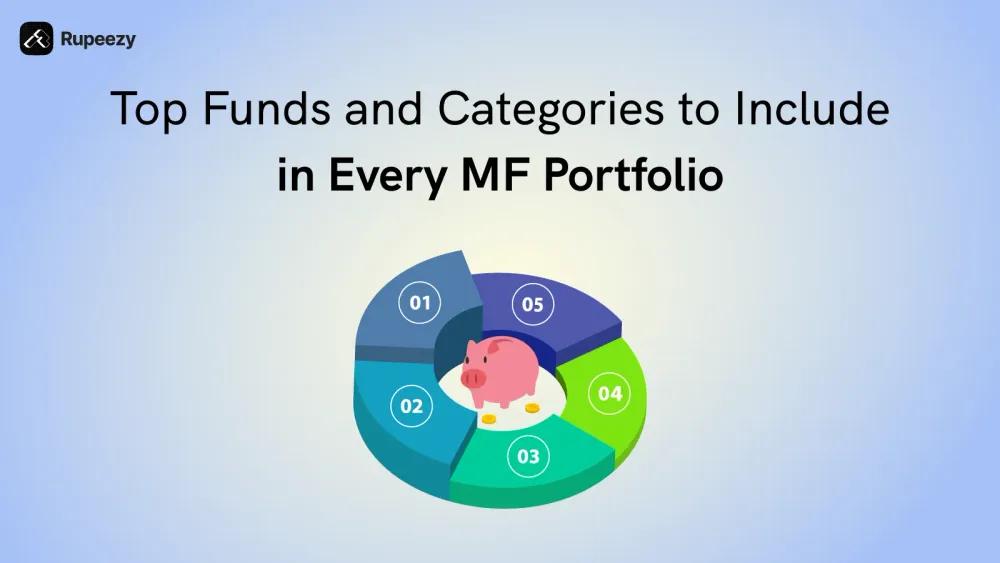Top Funds and Categories For Your Mutual Fund Portfolio


00:00 / 00:00
We often chase the dream of earning more, believing it's the ultimate key to financial security. Yet, the real magic happens not in how much you earn, but in how wisely you manage and invest what you already have. Think of it like you are a skilled chef who does not just focus on acquiring expensive ingredients, but you master the art of blending them to create a masterpiece. Your financial life is no different!
But the catch here is that the financial planning is rarely a ‘one-size-fits-all’ recipe. Your investments cater in accordance with your lifestyle, your personal goals, and your comfort level with risk. And while dedicating a healthy 30% of your income towards investments is a fantastic starting point, the moment you begin to split that amount across various funds, a familiar question emerges as to “Where do I even begin?”
This is precisely where many aspiring investors find themselves stuck, staring at a confused array of choices. And the good news is, Mutual Funds often come to the rescue and simplify what feels like an impossible decision, as they are hailed as the go-to choice for everyone, from beginners taking their first step to seasoned investors looking for efficiency.
But why is a mutual fund chosen as an effective investment decision? It is because they offer a convenient, professionally managed, and inherently diversified path to grow your wealth, letting expert fund managers do the heavy lifting. Again, although these mutual funds are simplified, the core dilemma remains as to “Which mutual fund truly deserves a place in your portfolio?”
That’s the real question we are here to answer! In this article, we will cut through the overwhelming clutter and guide you through the top mutual fund categories and specific funds that are nearly universally essential. Now, let’s explore how you can invest smarter, not harder, and build a portfolio that truly works for you!
Overview of Best Categories and Funds for Your Mutual Fund Portfolio
Now that we have cleared the fog on why investing matters and why mutual funds are such a powerful tool, the million-dollar question still remains unanswered. And that is, “Why Mutual Funds?” and “Which mutual funds are the right ones for your portfolio?”
The answer is simple. Mutual funds offer a low-entry investment option, starting with amounts as small as Rs 100, while giving you access to a diversified portfolio managed by seasoned professionals and also catering to various investors' needs. This means you can grow your wealth steadily without needing to pick individual stocks or time the market.
So, now, let us look at the best mutual fund categories and a few of their specific funds that truly deserve a spot in nearly every investor’s wealth-building journey.
A) Wealth Creation Mutual Funds
For wealth creation, Equity mutual funds are the best option. They are a type of mutual fund that primarily invests in the stocks (equities) of publicly traded companies.
Suitable for:
Individuals with a long-term investment horizon.
Individuals who possess a moderate to high-risk appetite.
Ideal for those seeking significant capital appreciation.
Under this category, let us have a look at the best 4 equity mutual fund sub-categories to include in your investment portfolio.
1) Large Cap Equity Mutual Funds:
These large-cap equity funds primarily invest in the stocks of the top 100 Indian companies by market capitalization, as defined by SEBI. They typically offer more stability and consistent returns, as they comprise well-established, industry-leading companies with a proven track record. While growth might be slower than smaller companies, they are generally considered less volatile and a relatively safer option for equity exposure.
The top mutual funds under the Large Cap Equity sub-category with 5-year CAGR are:
Nippon India Large Cap Fund with 26.15% CAGR.
ICICI Prudential Bluechip Fund with 23.59% CAGR.
HDFC Large Cap Fund with 22.82% CAGR.
Aditya Birla Sun Life Frontline Equity Fund with 22.00% CAGR.
Kotak Bluechip Fund with 21.58% CAGR.
2) Mid-Cap Equity Mutual Funds:
These mid-cap equity funds focus on companies ranked from 101st to 250th by market capitalization. Mid-cap companies are often in a strong growth phase, possessing established business models but still with significant room to expand. They offer a balance between the stability of large caps and the higher growth potential (and higher risk) of small caps, making them suitable for investors with a moderate risk appetite.
The top mutual funds under the Mid-Cap Equity sub-category with 5-year CAGR are:
Motilal Oswal Midcap Fund with 36.94% CAGR.
Edelweiss Mid Cap Fund with 33.86% CAGR.
Nippon India Growth Fund with 33.60% CAGR.
HDFC Mid-Cap Opportunities Fund with 33.14% CAGR.
Quant Mid Cap Fund with 32.73% CAGR.
3) Small Cap Equity Mutual Funds:
These small-cap equity funds invest predominantly in companies ranked 251st onwards by market capitalization. Small-cap companies are typically emerging businesses with immense growth potential, often operating in niche markets or with innovative ideas. While they carry the highest risk and volatility among the market capitalization categories, they also have the potential to deliver the highest returns if they succeed.
The top mutual funds under the Small Cap Equity sub-category with 5-year CAGR are:
Quant Small Cap Fund with 46.82% CAGR.
Nippon India Small Cap Fund with 38.31% CAGR.
Bandhan Small Cap Fund with 36.23% CAGR.
HSBC Small Cap Fund with 35.70% CAGR.
Bank of India Small Cap Fund with 35.04% CAGR.
4) Nifty 50 Index Equity Mutual Funds:
This is a type of passive mutual fund that aims to replicate the performance of the Nifty 50 Index. These funds invest in the same 50 largest and most liquid Indian companies that constitute the Nifty 50, in the same proportions. They offer broad market exposure to India's top companies at a generally lower cost (lower expense ratio) compared to actively managed funds, as the fund manager's role is simply to mirror the index.
The top mutual funds under the Nifty 50 Index Equity sub-category with 5-year CAGR are:
UTI Nifty 50 Index Fund with 20.73% CAGR.
HDFC Nifty 50 Index Fund with 20.58% CAGR.
DSP NIFTY 50 Index Fund with 20.583% CAGR.
ICICI Prudential Nifty 50 Index Fund with 20.51% CAGR.
SBI Nifty Index Fund with 20.41% CAGR.
B) Passive Income Mutual Funds
For passive income, Debt mutual funds are the best option. This type of mutual fund primarily invests in fixed-income securities. Instead of stocks, their portfolios consist of instruments like government bonds, corporate bonds, debentures, etc.
Suitable for:
Individuals who prioritize capital preservation.
Investors who have a low risk appetite.
Those who seek regular and stable income.
Investors who have short to medium-term financial goals.
Under this category, let us have a look at the best 3 debt mutual fund sub-categories to include in your investment portfolio.
1) Gilt Mutual Funds:
These funds invest exclusively in government securities (G-Secs) issued by the Central and State Governments. They are considered very low in credit risk as government bonds have virtually no default risk, but their returns can fluctuate due to interest rate movements, especially for longer duration gilts.
The top mutual funds under the Gilt sub-category with 5-year CAGR are:
ICICI Prudential Gilt Fund with 6.57% CAGR.
Edelweiss Government Securities Fund with 6.55% CAGR.
SBI Magnum Gilt Fund with 6.42% CAGR.
DSP Gilt Fund with 6.28% CAGR.
Axis Gilt Fund with 6.21% CAGR.
2) Dynamic Bond Mutual Funds:
These funds give their fund manager the flexibility to actively change the portfolio's duration and asset allocation based on their view of future interest rate movements. Their goal is to maximize returns by predicting rate changes, but their performance heavily depends on the fund manager's ability to forecast correctly, making them suitable for sophisticated investors.
The top mutual funds under the Dynamic Bond sub-category with 5-year CAGR are:
UTI Dynamic Bond Fund with 8.87% CAGR.
Aditya Birla Sun Life Dynamic Bond Fund with 7.79% CAGR.
360 ONE Dynamic Bond Fund with 7.48% CAGR.
ICICI Prudential All Seasons Bond Fund with 7.04% CAGR.
HDFC Dynamic Debt Fund with 6.84% CAGR.
3) Floating Rate Mutual Funds:
These funds invest in debt instruments where the interest rate paid to investors is not fixed but resets periodically (e.g., every 3 or 6 months) based on a benchmark rate. This feature helps them mitigate interest rate risk, as their returns adjust upwards when interest rates rise and downwards when rates fall.
The top mutual funds under the Floating Rate sub-category with 5-year CAGR are:
Kotak Floating Rate Fund with 6.99% CAGR.
HDFC Floating Rate Debt Fund with 6.95% CAGR.
ICICI Prudential Floating Interest Fund with 6.84% CAGR.
Nippon India Floating Rate Fund with 6.84% CAGR.
Aditya Birla Sun Life Floating Rate Fund with 6.58% CAGR.
C) Balanced Approach Mutual Funds
For a balanced approach, mutual funds, hybrid mutual funds are the best-suited ones. These mutual funds are like a balanced diet for your investment portfolio. Instead of investing solely in either equities or debt, they mix both asset classes within a single fund.
Suitable for:
Individuals who seek a balance between growth and stability.
Investors who have a moderate risk appetite.
Individuals looking for both equity and debt asset classes in a single fund.
Have medium to long-term financial goals.
Under this category, let us have a look at the best 3 hybrid mutual fund sub-categories to include in your investment portfolio.
1) Aggressive Hybrid Mutual Funds:
Aggressive hybrid funds maintain a higher allocation to equities, typically investing between 65% and 80% in stocks, with the remaining 20% to 35% in debt instruments. They are designed for investors seeking substantial long-term capital appreciation, willing to take on moderate risk to benefit from the equity market's upside, while the debt component provides a cushion.
The top mutual funds under the Aggressive sub-category with 5-year CAGR are:
Bank of India Mid & Small Cap Equity & Debt Fund with 27.70% CAGR.
JM Aggressive Hybrid Fund with 26.88% CAGR.
Quant Absolute Fund with 26.79% CAGR.
ICICI Prudential Equity & Debt Fund with 25.73% CAGR.
UTI Aggressive Hybrid Fund with 22.04% CAGR.
2) Conservative Hybrid Mutual Funds:
Conservative hybrid funds have a predominantly debt-oriented portfolio, allocating 75% to 90% of their assets to debt instruments and only 10% to 25% to equities. They are designed for investors with a low-risk appetite who prioritize capital safety and stable income, seeking slightly better returns than pure debt funds by taking a small, controlled exposure to equity.
The top mutual funds under the Conservative sub-category with 5-year CAGR are:
HDFC Hybrid Debt Fund with 12.57% CAGR.
Bank of India Conservative Hybrid Fund with 12.56% CAGR.
Aditya Birla Sun Life Regular Savings Fund with 12.17% CAGR.
SBI Conservative Hybrid Fund with 12.13% CAGR.
Kotak Debt Hybrid Fund with 12.07% CAGR.
3) Dynamic Asset Allocation Mutual Funds:
Dynamic asset allocation funds actively shift their allocation between equity and debt based on changing market conditions and valuation models, rather than a fixed ratio. The fund manager has the flexibility to increase equity exposure when markets are perceived as undervalued and reduce it during overvalued or volatile periods, aiming to deliver consistent returns while managing downside risk.
The top mutual funds under the Dynamic Asset Allocation sub-category with 5-year CAGR are:
HDFC Balanced Advantage Fund with 24.90% CAGR.
Baroda BNP Paribas Balanced Advantage Fund with 17.22% CAGR.
ICICI Prudential Balanced Advantage Fund with 15.94% CAGR.
Edelweiss Balanced Advantage Fund with 15.54% CAGR.
Aditya Birla Sun Life Balanced Advantage Fund with 15.42% CAGR.
(Note: All the above values were recorded as of 9th June, 2025, and the CAGR is in accordance with 5 years).
D) Gold Mutual Funds
Gold mutual funds offer a unique way to participate in the gold market without the complexities of buying, storing, or securing physical gold. Essentially, these are mutual fund schemes that invest primarily in gold-related assets. Most commonly, they invest in Gold Exchange Traded Funds (ETFs), which themselves hold physical gold bullion.
Here, the value of your investment will fluctuate with the price of gold in the market. You get exposure to gold's price movements and potential appreciation, but without the hassles associated with physical gold, like purity concerns, making charges, storage costs, or the risk of theft.
Under this category, we have listed the top 5 Gold Mutual Funds based on their AUM:
HDFC Gold ETF Fund of Fund with Rs 3,303 crore AUM.
SBI Gold Fund with Rs 3,225 crore AUM.
Kotak Gold Fund with Rs 2,655 crore AUM.
Nippon India Gold Savings Fund with Rs 2,623 crore AUM.
ICICI Prudential Regular Gold Savings Fund (FOF) with Rs 1,741 crore AUM.
Why Invest in Gold Mutual Funds?
Let us look at the main points and understand the importance of Gold mutual funds in an investor’s portfolio.
1) The ‘Safe Haven’ Charm:
When storms hit the stock market and the economy, investors often rush to gold, as it is perceived as a universal store of value, a safe haven. This means that when your equity investments might be suffering, your golf investment might be holding steady or even appreciating, acting as a valuable counter-balance.
2) A Hedge Against Inflation:
As we discussed, inflation erodes purchasing power. Gold has historically shown a strong ability to preserve wealth during periods of high inflation. When currencies lose value, gold often maintains or increases its value, protecting your wealth from being eaten away.
3) Diversification:
Gold often moves independently of stocks and bonds. This low correlation makes it an excellent diversification tool, helping to reduce the overall volatility of your portfolio. When some assets are down, gold might be up, smoothing out your overall returns.
4) Simple and Liquid:
Unlike physical gold, Gold Mutual Funds are easy to buy and sell through your existing Demat and trading account. You don't worry about storage, extra charges (like making charges), insurance, or purity.
Why is Investing in Mutual Funds a Good Idea?
Let us explore why investing in mutual funds is often hailed as a smart choice for this very purpose:
1) Simplified Diversification:
In a mutual fund, you own tiny pieces of many different assets across various sectors and industries. If one company stumbles, it is just a small ripple, and not a tidal wave, because your investment is not ‘all eggs in one basket’. This inherent diversification is a cornerstone of risk management, which is tough to achieve as an investor with limited capital.
2) Professional Expertise on Your Side:
Imagine having a team of seasoned financial experts working tirelessly to pick the best stocks for your money. That is exactly what the fund managers in a mutual fund do for you. They constantly monitor market trends, economic indicators, and company performance, making informed decisions on your behalf, freeing you from self-research.
3) A Safety Net During Turmoil:
When markets get volatile and inflation surges unexpectedly, strategic investment diversification becomes a smarter move. And Gold Mutual Funds come in handy and serve as a ‘safe haven’ during economic uncertainty. This acts as an important counterbalance, providing a layer of protection when other assets might be struggling.
4) Potential For Passive Income:
Debt mutual funds primarily invest in bonds and other fixed-income instruments, providing regular interest income. While the primary goal of these funds is to appreciate capital, the income component adds another layer of return.
5) Affordability and Accessibility:
You do not need great possessions of money in order to start investing in mutual funds; instead, with Systematic Investment Plans (SIPs), you can begin your mutual funds journey with as little as Rs 100. This makes investing accessible to almost everyone, fostering disciplined savings and compounding even from small regular contributions.
Conclusion
For many, the path to smart investing leads directly to mutual funds. And here, we explored how these expertly managed, diversified baskets of securities simplify the complex world of the markets, offering professional guidance and built-in risk reduction.
Ultimately, your financial journey is completely unique when compared to others. The ‘top funds’ are not a secret list; rather, they are the ones that might align perfectly with your personal goals, your risk tolerance, and your investment horizon. By understanding the categories that we have discussed and appreciating the roles they play, you are now equipped to make informed choices.
Check Out These Related Articles |
The content on this blog is for educational purposes only and should not be considered investment advice. While we strive for accuracy, some information may contain errors or delays in updates.
Mentions of stocks or investment products are solely for informational purposes and do not constitute recommendations. Investors should conduct their own research before making any decisions.
Investing in financial markets are subject to market risks, and past performance does not guarantee future results. It is advisable to consult a qualified financial professional, review official documents, and verify information independently before making investment decisions.

All Category









